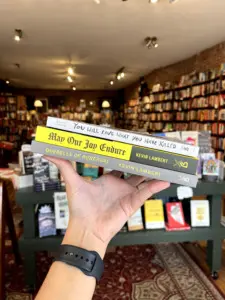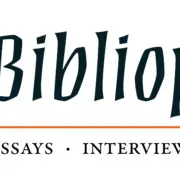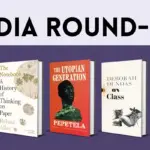The Bibliophile: May You Enjoy Your Stuff
Want to get new excerpts, musings, and more from The Bibliophile right away? Sign up for our weekly newsletter here!
***
Lots of exercises are tricky: distinguishing your backlist from your frontlist; packing up your life and moving to another city; burpees. In last week’s newsletter, Vanessa helped with the first item. This week, I plan to help with the second. May god help you with the third.
I have had at least seven different mailing addresses across three cities over the last ten years. It might not be surprising then that I’ve become proficient at packing my life into boxes and bags and have completely given up on owning hangable artwork (I get tattoos now). To clarify, I never set out to be a digital nomad or minimalist. My circumstances have dictated that I choose which physical things to own very carefully. Having (approximately) exactly what you need makes the packing and moving process a lot less painful than it otherwise would be. You don’t want to trip while you’re carrying a box of deteriorating Teflon non-stick pans down a winding staircase (true story).
These days, I tend to only keep material goods that bring a high degree of utility and aesthetic value to my life. The mugs that I own, for instance, are all different sizes and represent my various interests from wabi-sabi interior design to Star Wars. I also tend to only keep books I would re-read, find beautiful to look at, and are comfortable to hold. Until our author interview with Kev Lambert, I hadn’t paid too much conscious attention to what these items say about me. Kev, by the way, is the author of Que Notre Joie Demeure, a runaway bestseller that was shortlisted for the 2023 Goncourt Prize, and won the 2023 Médicis Prize (making Kev the first Canadian writer in a couple of generations to win this most prestigious of French awards). Donald Winkler’s translation into English, May Our Joy Endure will be available September 3, 2024. The novel transports readers into the lives of the ultra-privileged, primarily following Céline Wachowski, an internationally renowned architect who is accused of destroying struggling neighborhoods in Montreal with her plans for a newly commissioned project—the Webuy Complex. In a time of widening wealth disparity and rising costs of living, Céline’s depicted lavish lifestyle is simultaneously alluring and terrible. When we asked about their intentions behind these details in May Our Joy Endure, Kev shared some nice food for thought about our relationship to material things:
Q:
Let’s talk about the stuff in this novel, from the fashion (Comme des Garçons, Vivienne Westwood and Marie St. Pierre), to the books (from Lacan, to Tremblay, to Proust), to the wine, (they don’t drink white, they drink Sancerre), to the architectural materials (one of the characters has Corten Steel on the front door of his house which is beautiful but he fears was too trendy and is now dated). This is a novel about material culture that is very detailed in terms of what our culture is made of and how it is all put together. Why are these details important to both the novel’s aesthetic and its ambivalent perspective on cultural “makers” to use an ascendant if dubious term.
A:
There’s a sociological aspect to these decisions: these are all signs of distinction. Céline is ultra-rich but she doesn’t see herself as vulgar. Even if Céline is, in fact, nouveau riche because her money isn’t old, she certainly doesn’t want to be seen as nouveau riche, because she wants to be seen as a kind of radical aesthetic figure of the avant-garde. She has to communicate this in her style. She couldn’t wear Chanel because it’s too conservative and classic. So there’s an aspect of the referentiality that is character development. While I’m critical of these objects that are completely caught up in a capitalist culture of consumerism, there are still brilliant people who have thought about these clothes in an aesthetic way. You don’t need to own the object to see it and to understand its value. These materials in the novel also operate as a kind of intertextuality—the fashion designers the characters wear, the art on their walls, the food they eat, the opening nights they attend, it’s never insignificant. It’s a way of winking at the reader, of encouraging them to gain some critical distance from the world of Céline and of the novel at one moment and of pulling them in closer the next.

Photo: Kev’s Biblioasis books May Our Joy Endure, Querelle of Roberval, and You Will Love What You Have Killed.
So, as it is at the conclusion of a move, there seems to be much to unpack in May Our Joy Endure. The things we own might be valuable insofar as they: help us do things, mean something to us, and reflect us back into the world. To make matters more complex, this value might change over time as when our phone batteries die and cease to function (thanks to planned obsolescence) or when you can suddenly pull a leopard print coat from the back of your closet to look cool on a night out (thanks to the trending ‘mob wife aesthetic’). And presumably, we tend to hold onto our valuables and are more willing to let go of the less valuable. Quick—you can only grab three things on your way out of your burning home—what are you rescuing? The exercise of moving homes forces you to entertain a less intense version of this thought experiment, though it still confronts you about your relationship to everything you own.
Unlike the nouveau riche characters in May Our Joy Endure, I have grown into the habit of gently decluttering regularly and being very slow to purchase or borrow new-to-me things. My turnover of things has decreased, which in turn, has increased my awareness and appreciation for the things I have. It just so happens that this also reduces the stress associated with packing up your life and moving onto your next chapter since you already have a good idea of what to bring.
Julia Lei
Publicist
***
Keep up with us!
- May Our Joy Endure by Kev Lambert (trans. by Donald Winkler) will be available on September 3, 2024.
- The Notebook by Roland Allen comes out the same day on September 3, 2024.
- A Way to Be Happy by Caroline Adderson can be purchased on September 10, 2024.
- The Pages of the Sea by Anne Hawk comes out in Canada on September 17, 2024.
- Comrade Papa by GauZ’ (trans. by Frank Wynne) will be published on October 8, 2024.










